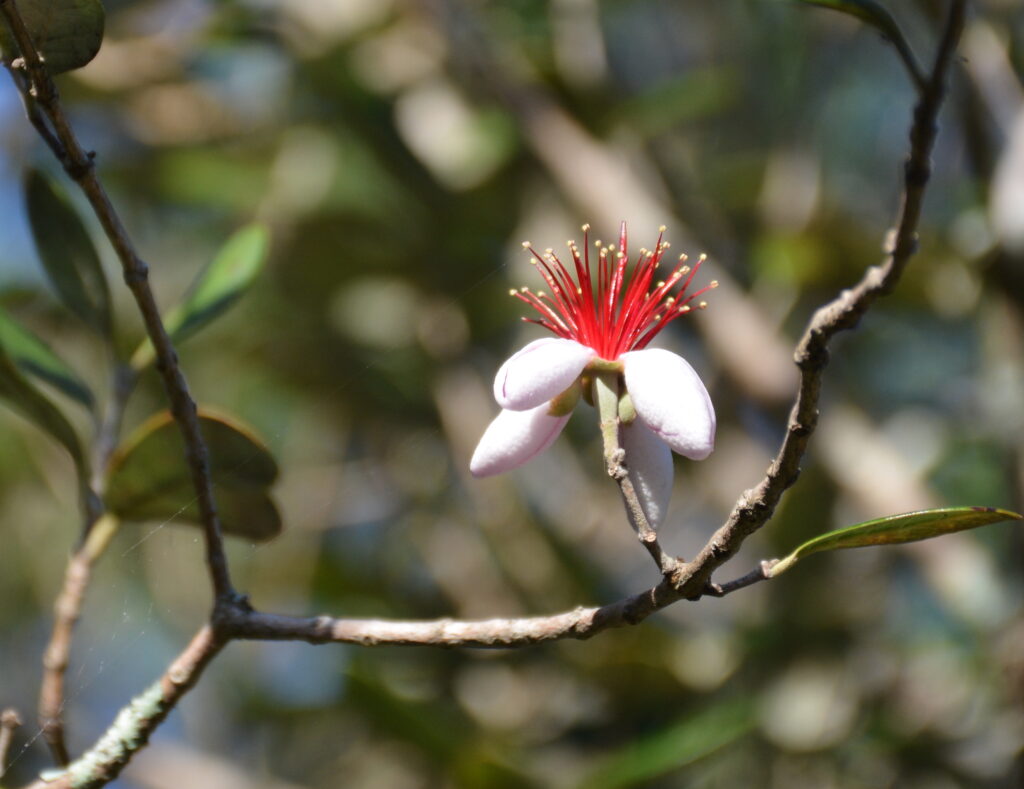
The striking blossom of the Pineapple guave is edible. Photo by Green Deane
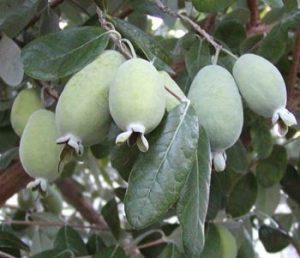
While ripe and unripe pineapple guava look the same, ripe is softer. Photo by Green Deane
Where do you find pineapple guava? Answer: In public parks. Although the species was highly publicised for home use it never caught on. As a moderate sized tree, it is a prime inoffensive candidate for city parks and that is where you will find it. I knew of three, one in Winter Park, one in Ocala and one in Jacksonville. The one in Ocala has since been removed along with a pomegranate beside it. Maybe the city thought fruiting trees on public property was too much of a legal liability.
Pineapple guava has edible blossoms, fruit and leaves that can be made into tea. It is not however showy. The blossoms are attractive though they hide well. The entire blossom is edible but most folks prefer the white petals to the rest of the flower.
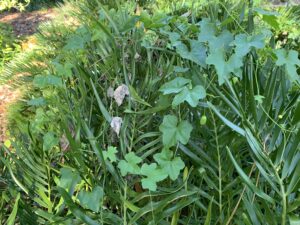
Fruit and leaves of the creeping cucumber are edible. Photo by Green Deane
Also seen this week were many creeping cucumbers. May is either the last of its season or the beginning of a new season. Usually if thee hasn’t been a frost or a freeze they just keep on producing. This little greenery will crawl over ground or climb, given the opportunity. Tall ornamental grass seems to be a preferred scaffolding. They are tasty when light to medium green, and a laxative when dark green and black.You can read about them here
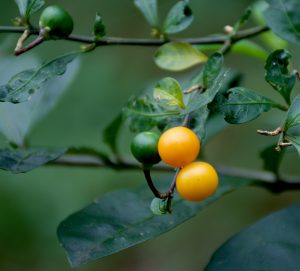
The controversial two-leaf nightshade. Photo by Green Deane
Between seasons is the two-leaf nightshade, solanum diphyllum. An easy-to-identify controversial plant the two-leaf is heavy with blossoms now. They turn into small green fruit that ripen to yellow. A member of the night shade family it is widely reported as toxic and is also widely eaten. The effects of solanum glycocides are usually dose-related. The plant’s solanin has been implicated in cattle poisoning but cattle also eat leaves and twigs besides fruit. And kids have been sickened by the fruit, which they tend to eat in excess and they are small humans. Symptons can include anorexia, nausea, and vomiting. Adults seem to nibble on the fruit without significant repercussions. Then again, that is eating just a few at a time, not a jam or pie made from them. I think they have a pleasant taste and I only eat a few at a time as that is all I ever find ripe at one time. As vinegar removes solanin, perhaps pickling them might be a solution. Heating to over 392 F also destroys solanin. All of the two-leaf nightshade I have seen have had yellow fruit. Most botanical references say the ripe fruit is orange.

Foraging classes are held rain or shine, heat or cold. Photo by Nermina Krenata
Foraging Classes: We visit two coastal location this weekend, Largo and Melbourne.
April 29th, Eagle Lake Park, 1800 Keene Road, Largo, FL 33771. Meet at the pavilion near the dog park. 9 a.m.
April 30th Wickham Park, 2500 Parkway Drive, Melbourne, FL 32935-2335. Meet at the “dog park” inside the park , 9 a.m.
Bring cash on the day of class or click here to pay for your class
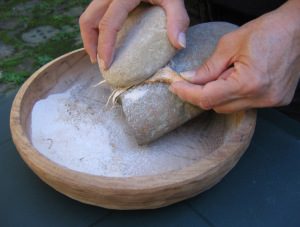
No plant produces more starch per acre than cattails.
If you were starving and came upon a patch of cattails (blossoming now) you would have great cause for celebration. You have found food and water. You will survive. But if you are not starving and do not have all the time in the inter-connected world you just might find cattails highly overrated. It is true that no plant can produce more starch per acre than cattails, about 3.5 tons under cultivation. And it can produce a lot of starch economically if you can mechanize the extraction. But hand extraction is time- consuming and labor intensive. It is also wet, smelly work all of which can be worsened significantly by harvesting in cold weather. So yes, cattails are food but the time demand is such that harvesting food has to be your prime occupation. A similar argument can be made for kudzu. The roots do have edible starch but it takes a gargantuan amount of work to get the starch out, literally hours of steady pounding. It is not a calorie positive activity. It moves you closer to starvation. But, mechanize the process with some hammers run by falling water — or hammers run by a horse fed on an endless supply of grass — and kudzo becomes a reliable calorie-positive food. You can see my video on cattails here. pounding. I also have an article on Finding Caloric Staples with links to relevant videos.
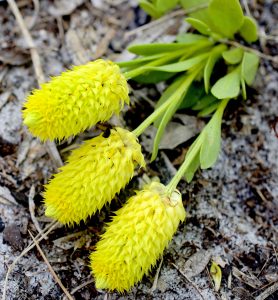
Candyroot and be yellow or orange, tall and short.
In the realm of plant populations there is endangered, threatened then rare. But there is a huge distance between rare and common. The yellow bloomer to the right — Candyroot — is not on any about-to-disappear list but one doesn’t see them that often. You have to be at the right place — seasonally damp pine scrub — and the right season, May in Florida but it can be found later in the year. Candyroot comes in two colors, yellow that can sometimes make it to orange. Native Americans and early Europeans would chew the roots, which have a spearmint-esque flavor, or wintergreen, and to some palates licorice. The tap root is also rather small, so it’s not much of a chew. Kind of like a woodland breath mint. To read more about Candyroot you can click here.

You get the USB, not the key.
My nine-DVD set of 135 videos has been phased out and replaced by 171-videos on a 128-GB USB, see right. The USB videos are the same videos I have on You Tube. Some people like to have their own copy especially if social order falters. The USB videos have to be copied to your computer to play. If you want to order the USB go to the DVD/USB order button on the top right of this page or click here. That will take you to an order form. Or you can make a $99 donation, which tells me it is for the USB (include a snail-mail address.) I’d like to thank all of you who ordered the DVD set over the years which required me to burn over 5,000 DVDs individually. I had to stop making them as few programs now will read the ISO files to copy them. Burning a set also took about three hours.

Green Deane Forum
Want to identify a plant? Perhaps you’re looking for a foraging reference? You might have a UFO, an Unidentified Flowering Object, you want identified. On the Green Deane Forum we — including Green Deane and others from around the world — chat about foraging all year. And it’s not just about warm-weather plants or just North American flora. Many nations share common weeds so there’s a lot to talk about. There’s also more than weeds. The reference section has information for foraging around the world. There are also articles on food preservation, and forgotten skills from making bows to fermenting food. Recent topics include: Stale Bread and Cod Liver Oil, Killing Bugs with Tobacco Plugs, Eating weeds: Is it safe? Have they mutated? Not the Eastern Red Bug but the Pink Tabebuia, African Tulip Tree, Asparagus densiflorus, Green Deane’s Book… You can join the forum by clicking on the button on the upper right hand side of this page.
This is my weekly newsletter #555. If you want to subscribe to this free newsletter you can find the sign-up form in the menu at the top of the page. My website, EatTheWeeds.com, which is data secure, has over 1500 plants on it in some 428 articles. I wrote every one myself, no cut and paste.
To donate to the Green Deane Newsletter click here.

